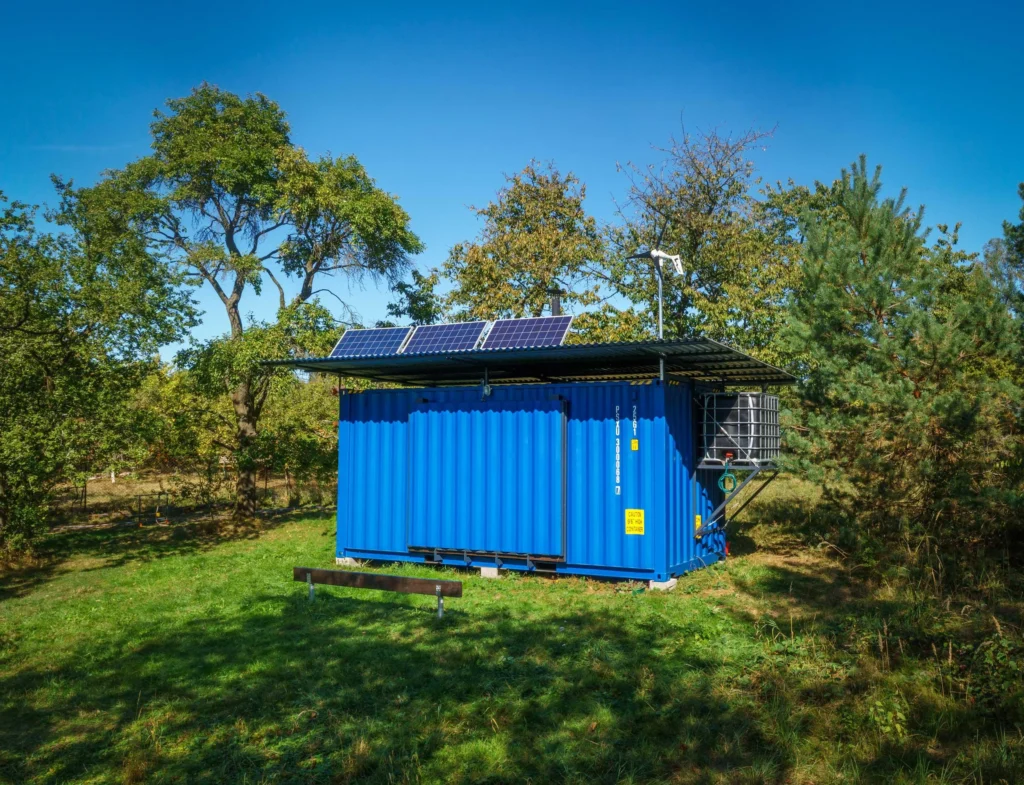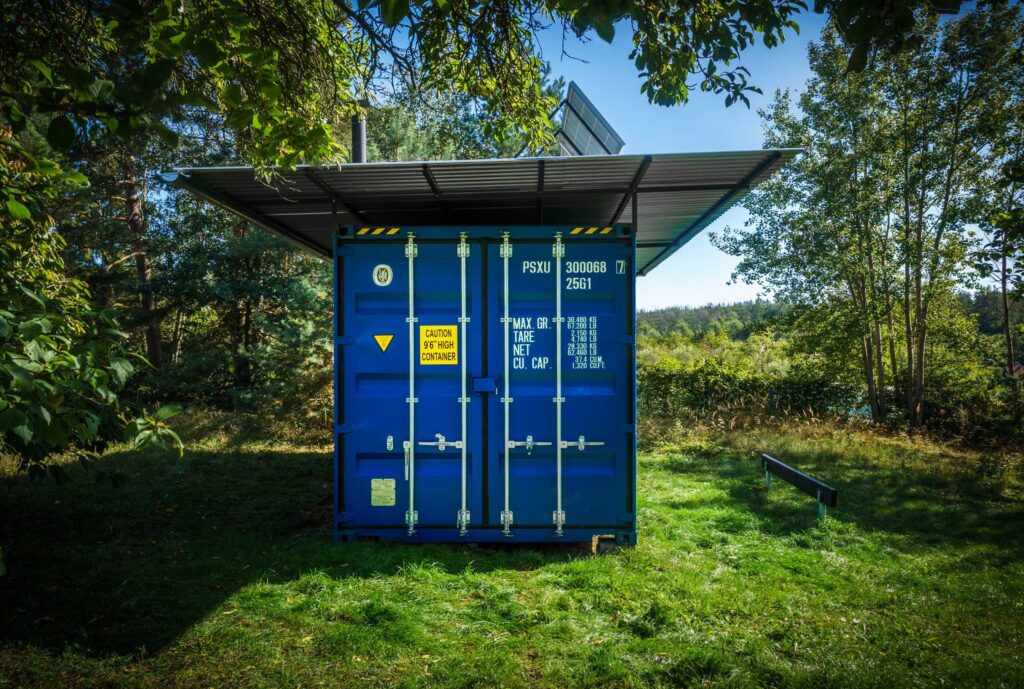Off-Grid Container Homes: The Future of Sustainable Living. In recent years, the pursuit of sustainable living has prompted a surge in innovative housing solutions. Among these, off-grid container homes have emerged as a popular choice for individuals and families seeking to minimize their environmental footprint while enjoying the benefits of unique, modern living spaces. This blog post delves deep into the concept of off-grid container homes, detailing their features, benefits, construction options, and the differences between 20ft and 40ft container homes.
Understanding Off-Grid Living
What does “off-grid” mean?
Off-grid living refers to a lifestyle that operates independently from centralized utility systems, focusing instead on self-sufficiency in basic needs such as water, electricity, and waste management. Off-grid enthusiasts often embrace renewable energy sources like solar, wind, or hydropower and aim to cultivate a sustainable lifestyle that minimizes reliance on non-renewable resources.
The Rise of Container Homes

The Concept of Container Homes
Container homes are innovative housing solutions created using shipping containers. Initially designed for transporting goods across oceans, these steel boxes have been repurposed into modern, stylish residences that blend functionality with unique architectural designs. Container homes can be modified to meet various aesthetic, size, and utility needs, making them an appealing option for a wide range of individuals.
Why Choose Off-Grid Container Homes?
- Sustainability: Container homes utilize recycled materials, reducing waste and making them a fundamentally sustainable choice.
- Cost-Effective: Compared to traditional housing options, container homes can often be constructed at a lower cost, especially when built off-grid.
- Mobility: Container homes can be relocated, making them an excellent option for those who want to explore different locations.
- Modern Aesthetics: With creative design, container homes offer a sleek and modern aesthetic that appeals to a wide audience.
Features of Off-Grid Container Homes
When selecting between various container home options, it’s essential to consider the unique features each type offers. Here, we will explore the defining features of both 20ft and 40ft container homes.
Features of 20ft Container Homes
Dimensions and Layout
A standard 20ft shipping container measures approximately 8ft wide and 8.5ft high, providing about 160 square feet of living space. This compact area can be optimized for various living arrangements, including:
- One-bedroom layout: An efficient use of space for individuals or couples.
- Open-plan living area: Combining kitchen and living space for a minimalistic lifestyle.
Cost-Effectiveness
20ft container homes are an economical choice due to their smaller size, making them easier and cheaper to transport and install. Additionally, the reduced need for materials and fewer building permits can further lower costs.
Off-Grid Features
With the smaller footprint, 20ft container homes can be equipped with essential off-grid technologies:
- Solar Energy Systems: Solar panels can be strategically placed on the roof to provide electricity.
- Rainwater Harvesting Systems: Gutter systems can funnel rainwater into storage tanks for drinking and irrigation.
Customization Options
While limited in size, 20ft container homes can still reflect the owner’s personality through interior design and external modifications, including:
- Large windows: Enhancing natural light.
- Sustainable materials: Utilizing reclaimed wood and recycled materials.
Features of 40ft Container Homes
Dimensions and Layout
A standard 40ft shipping container offers about 320 square feet of living space, providing greater flexibility in layout options compared to its 20ft counterpart:
- Two-bedroom layout: Designed for families or larger groups.
- Dedicated office space: Ideal for remote workers.
Increased Living Space
The additional square footage in a 40ft container allows for more spacious living arrangements, accommodating larger kitchen areas, bathrooms, and living rooms while maintaining an off-grid lifestyle.
Off-Grid Features
Just like 20ft homes, 40ft containers can integrate advanced off-grid technologies, but can also allow for more sophisticated systems:
- Wind Turbines or Hybrid Systems: Adding wind turbines alongside solar panels enhances energy production.
- Advanced Waste Management: Composting toilets and greywater systems can be implemented more effectively.
Customization Options
The larger size of 40ft containers allows for more extensive customization, such as:
- Expandable living areas: Incorporating slide-outs or adding additional containers for expansion.
- Enhanced insulation and climate control: Improved heating and cooling systems for year-round comfort.
Comparing 20ft and 40ft Container Homes
When deciding between a 20ft and a 40ft container home, several factors come into play:
Size and Space
The most obvious difference lies in the size. A 40ft container provides twice the space of a 20ft container, making it easier to accommodate additional bedrooms, living areas, or even spaces for hobbies and work.
Cost Considerations
While 20ft containers are generally more affordable, a 40ft container provides more value based on the added space, comfort, and potential resale value.
Portability
Both container sizes offer portability, but 20ft containers are easier to transport due to their smaller size. However, a 40ft container can also be moved but may incur higher transportation costs.
Energy Efficiency
Larger spaces may require more energy for heating and cooling. A well-designed 40ft container can feature a strategic layout to enhance efficiency but may need more robust systems compared to a 20ft container.
The Components of an Off-Grid Container Home
To craft a sustainable and functional off-grid container home, several essential components must be considered:
Energy Generation Systems
- Solar Panels: The most popular choice for off-grid living, solar energy systems harness the sun’s energy, converting it into electricity to power your home.
- Wind Turbines: These systems can complement solar panels, utilizing wind energy for additional off-grid capabilities.
- Hydropower Systems: For those with access to flowing water, micro-hydropower generators can provide a reliable source of energy.
Water Supply Systems
- Rainwater Collection: Installing a rainwater collection system can provide water for non-potable uses.
- Well Drilling: For more sustainable water needs, drilling a well may ensure an ongoing water supply.
Waste Management Solutions
- Composting Toilets: These eco-friendly toilets turn human waste into compost, reducing water usage and minimizing waste output.
- Greywater Recycling: Systems that reuse water from sinks and showers can help offset water demands in off-grid living.
Insulation and Climate Control
Proper insulation is essential for maintaining a comfortable internal environment. For off-grid container homes, the following methods can be employed:
- Spray Foam Insulation: This high-efficiency insulation method offers excellent thermal resistance and helps regulate temperature.
- Reflective Barriers: Using reflective surfaces can aid in keeping the containers cool during hot months.
Interior Design
The design of your container home should prioritize functionality and aesthetics. Some popular design tips include:
- Minimalist furniture: Choose furnishings that can serve multiple purposes, such as a fold-out sofa or a coffee table with storage.
- Natural light: Install large windows or skylights to enhance the living experience.
Building Your Off-Grid Container Home
Constructing your off-grid container home involves several steps to ensure compliance with regulations and satisfactory results:
Step 1: Research Local Regulations
Before starting construction, researching local zoning and building codes is critical. Some areas may have specific regulations regarding container homes, such as size restrictions or required permits.
Step 2: Select the Right Container
Decide whether a 20ft or 40ft container suits your needs based on size, intended use, and budget. Inspect used containers for structural integrity, rust, and damages.
Step 3: Plan the Layout
Develop a detailed plan for your container home, considering the number of rooms, types of off-grid systems, and overall design aesthetic. CAD software can be helpful for visualizing the layout.
Step 4: Modify the Container
Modify the container to create openings for windows, doors, and electrical installations. Hire professionals for cutting and welding if needed.
Step 5: Install Off-Grid Systems
Install your chosen off-grid systems, including electricity generation, water supply, and waste management systems. Ensure all systems meet safety standards.
Step 6: Design the Interior
Once the essential systems are in place, focus on the interior design by selecting sustainable materials and furnishings that complement your living space.
Step 7: Landscaping
Don’t forget the outside! Create a functional landscape that includes sustainable practices like permaculture gardens and native plant landscaping that requires minimal upkeep.
Benefits of Off-Grid Container Homes
- Environmental Impact: With energy, water, and waste management systems in place, off-grid container homes have a relatively low carbon footprint.
- Resilience: Off-grid living provides a sense of independence and resilience against economic fluctuations and unreliable utility services.
- Connection with Nature: Living off-grid often means residing in natural settings, helping to foster a stronger connection to the environment.
- Community Living: Many off-grid container home enthusiasts exist within communities of like-minded individuals, offering opportunities for shared resources and support.
Challenges of Off-Grid Container Homes
- Initial Costs: Although container homes can save money in the long run, the initial investment in off-grid systems and modifications can be significant.
- Maintenance: Off-grid living requires consistent attention to energy, water, and waste management systems, which may pose challenges for some homeowners.
- Learning Curve: Adapting to a self-sufficient lifestyle will take time and effort, particularly for those unfamiliar with off-grid systems.
Conclusion
Off-grid container homes present a revolutionary approach to sustainable living, offering individuals and families a unique opportunity to create functional residences while reducing their environmental impact. The decision between a 20ft and a 40ft container home should take into account individual needs, budgets, and lifestyle preferences.
By embracing advanced off-grid technologies and sustainable practices, homeowners can enjoy not just a house, but a lifestyle that reflects their values and dedication to a greener planet. As the demand for sustainable living solutions continues to rise, off-grid container homes stand poised to redefine our approach to what it means to live harmoniously with nature.




